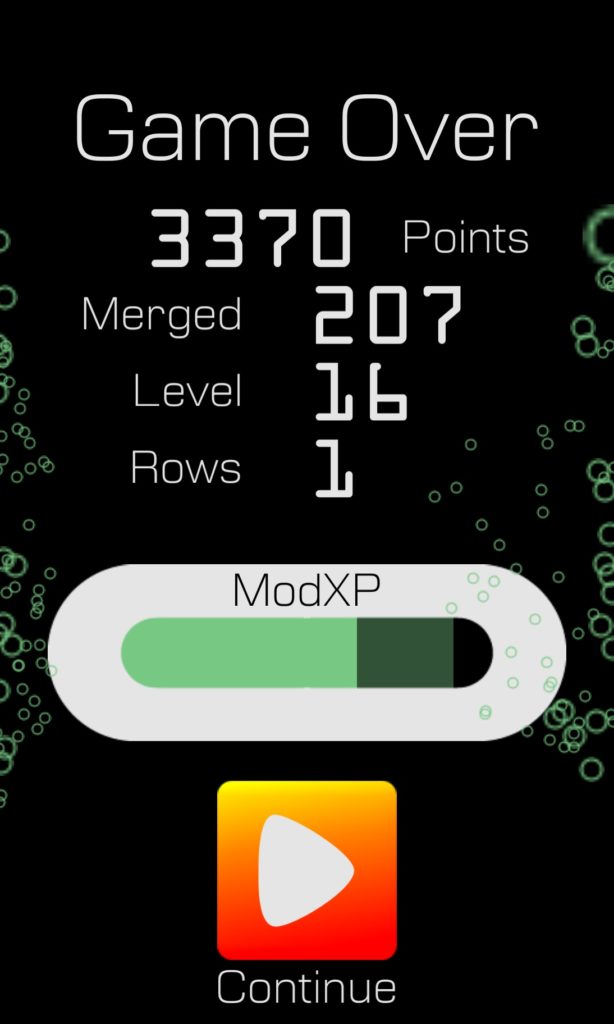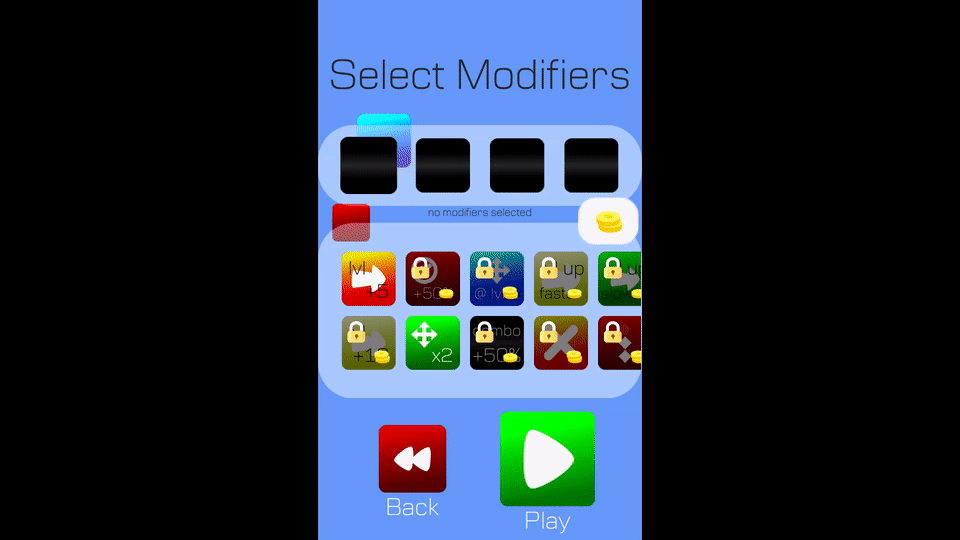Part 2 of a discussion of game design decisions made for BuildDown. Part 1 is here.
BuildDown is a simple, action-oriented game, which made it somewhat challenging to figure out how to monetize. There are no levels, so I can’t exactly sell more content. The mechanics are not friendly to puzzles to force such a content model, either. Instead, I had to weigh the various popular approaches to see which played best to the strengths of the game.
Purchase
The simplest solution would be to just sell the game. Unfortunately, reality is not kind to up-front purchases on mobile. When even free games are a dime an infinity (and infinitely more likely to be passed over than played), the only developers who can get away with asking a customer to buy a game sight unseen have either a lot of positive media or a feature on the App Store, and I couldn’t count on an expensive PR campaign or a miracle.
Life Model
Create artificial scarcity in gameplay time, then sell it back to the player! At its worst, this is a transparent and devious way to exploit the sunk-cost fallacy: compared to losing a bunch of progress, that in-app purchase looks mighty good. I find this model more than a little disingenuous, but there are lessons to be learned from it. Forcing a player to walk away for a while can make them less likely to burn out, and by putting value to an in-game resource, you can incentivize desired behavior (share our game with 5 friends!) in exchange for that resource.
Advertising (Banner)
This was the model I used for the first iteration of BuildDown. Unfortunately, I leveraged it poorly, even for the time. The ads were only on the title screen, so as not to ruin the gameplay. Of course, players spend next to no time on the title screen, which translated to next to no impressions. (To add insult to injury, some players still complained about the ad placement!)
Anyway, today banner ads are essentially extinct in games. Nobody notices an ad during anything compelling, let alone is so captivated (and willing to context-switch from a gaming mood to a buying mood) they click away from what they’re doing and convert to a sale. There might be a tiny amount of room for awareness ads (soda, cars) rather than sale ads (buy car insurance now), but those campaigns simply do not pay very well, and sellers now (fairly) price their eCPMs with very low expectations.
Finally, because conversions are so low, banner ads only reward one metric: volume of impressions. Of course, all ad returns scale with traffic, but there are ways to integrate better, smarter, and more targeted ads that can pay well even without top-of-the-charts reach.
Advertising (Interstitial)
From my first interaction with them, I hated interstitial ads. I hated being pulled out of the gaming experience against my will, often without warning. I hated sitting through an unskippable (probably excessively-long) commercial for something I didn’t care about. I hated them so much, in fact, I’d usually drop any game that subjected me to them without a second thought.
But, it doesn’t have to be that way. I like games! Relevant ads can be a positive experience, introducing me to content I wasn’t aware of and might even love. While poorly-done interstitials pull me out of the game I’m playing; well-done ones could immerse me in the potential of whole new games. That’s why I eventually fell in love with…
Advertising (Rewarded Interstitial)
A well-done rewarded interstitial is not just accepted, but maybe even desired. It acknowledges the relationship between the customer, developer, and advertiser; that is, I’m getting something for you watching this ad, so you should get something, too. (You know, besides getting to play this game I poured my blood, sweat, and tears into for absolutely no cost to you.)
But the best part is, they’re optional. The relationship is transactional – watch an ad, get a prize – but it’s not a prerequisite for enjoyment of the game, and the player retains the autonomy to make that decision for themselves.
In the case of BuildDown, our prize is experience (called ModXP). It’s earned fairly and generously just by playing. The interstitial advertisement is an optional accelerator, increasing the experience reward but in no way punishing the player if they choose not to do so.

Experience earns the player coins, which are in turn used to unlock…
Modifiers
One of the things I struggled with in earlier iterations of BuildDown was how to keep the game fresh over time, how to let it evolve and grow, when the core game didn’t really change from one session to the next. Modifiers add that necessary extra dimension to the game loop, empowering players to remix the game to their tastes every time they play.
Each modifier has a special effect that changes some rule of the game. Some modifiers exist to incentivize new strategies. Automerge worth 2x as many points will have players keeping a closer eye on falling blocks and building their flicking reflexes, while multiplier for merging blocks of the same color can turn a mad dash for merges into a juggling act of setting up potential merges and then hitting them hard all at once. Others, like more powerups (self-explanatory) and save (basically a get-out-of-game-over-free card) make the game friendlier to personal high scores, rewarding players for sticking around with more carrots and fewer sticks.

Modifiers provide an opportunity to change the game, but by themselves don’t necessarily encourage experimenting with new and different combinations. How do I make sure players don’t just keep picking the best ones over and over, producing the same stale loop? Our old friend artificial scarcity! Cooldown timers are used to prevent the player from reusing a modifier immediately after using it.
This also gives a second opportunity to monetize, as players can opt to watch an ad to skip the cooldown timer on all modifiers. This might seem a little cynical, like the cooldown timer only exists to wring impressions, but making the timer “pay” to skip actually serves an important purpose. By associating something of value (an awarded interstitial) with the cooldown timer, we communicate that the time has a defined value, just like in-game experience. A player could choose to skip the wait as many times as they like, but by putting a cost to the action, they’re more likely to respect the wait and try something new in the interim.
The length of each cooldown is based on multiples of typical play session lengths, so a short cooldown will become available after about one round, while a slightly more powerful modifier might take a couple of games to reset. Because they don’t all reset after the same amount of time, there is an incentive to unlock a large stable of modifiers to choose from, and more opportunities are created for players to try and discover interesting and serendipitous combinations. And how do players build their stable? Play the game more, earn more experience, and watch more ads!
So, does this monetization approach accomplish everything I wanted it to? It’s still to early to tell. It might in fact be too unobtrusive; the first time I submitted BuildDown to the App Store, Apple rejected it because they couldn’t find any ads! Hopefully, fans of the game have no such trouble.

